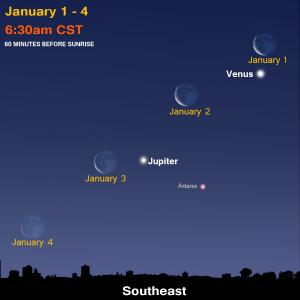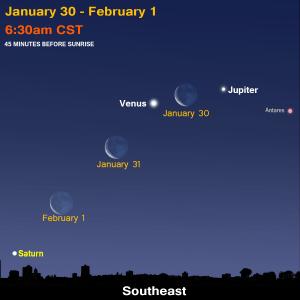Cosmic Curiosities
“I accept the universe.”
- Margaret Fuller, 19th-century USA Journalist
Subtle & Spectacular: A Total Lunar Eclipse
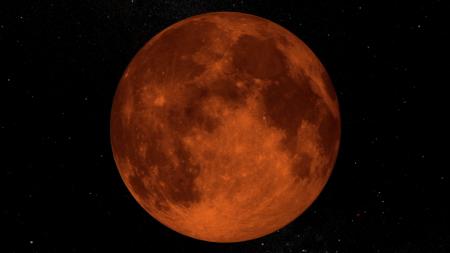 All eclipses are spectacular, but the total-lunar variety is slowly mesmerizing and subtle.
All eclipses are spectacular, but the total-lunar variety is slowly mesmerizing and subtle.
The Moon’s gradual disappearing act takes place on the night of January 20-21 -- cross your fingers for clear skies. The whole cosmic process takes over three hours! The Moon vanishes at a leisurely pace because of our great distance from it; however, the Moon is actually speeding quickly at 0.63 miles per second.
During the partial phase starting at 9:33 p.m. CST, the Moon will grow dark starting from its lower left position. The Earth’s shadow will creep up and to the right, slowly engulfing our night light. About 10 to 20 minutes before totality at 10:41 p.m., you will notice the Moon turn a slight orange-reddish color.
For the 62 minutes of the total lunar eclipse, take time to observe the changing colors. The darker red will be on the lower part of the Moon as it is deeper in the Earth’s shadow. Lately, people have been calling this part the Blood Moon. The red color is caused by the Sun’s light being refracted and dispersed by the Earth’s atmosphere. Only the longer energy wavelengths of red reach the lunar surface.
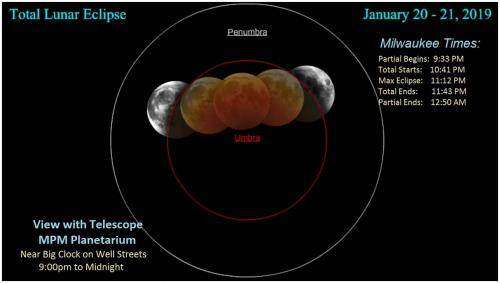 As the total phase nears its end, watch the Moon grow brighter toward its upper right. At 11:43 p.m., the Sun’s light once again reveals the familiar white-gray glow of the Moon. You can still notice some orange and red light from the partially eclipsed Moon for another 10-20 minutes.
As the total phase nears its end, watch the Moon grow brighter toward its upper right. At 11:43 p.m., the Sun’s light once again reveals the familiar white-gray glow of the Moon. You can still notice some orange and red light from the partially eclipsed Moon for another 10-20 minutes.
Bundle up and visit us at the Museum in downtown Milwaukee -- we will have telescopes set up to view the heavenly show. Clear skies only!
The last time we saw all of the total lunar eclipse in Wisconsin was over three years ago on September 27, 2015. The next complete cosmic conceal for the Moon is May 16, 2022.
On the Far Side of Pluto
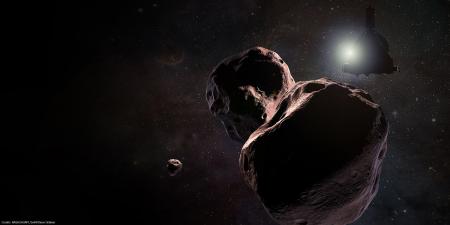 In July 2015, NASA’s New Horizons thrilled the curious with the first close-up pictures of distant Pluto. It took the speedy spacecraft almost 10 years to rendezvous with our favorite former planet. After another three-and-a-half years, it will encounter another cold world a billion miles beyond Pluto: On January 1, 2019 New Horizon will meet Ultima Thale.
In July 2015, NASA’s New Horizons thrilled the curious with the first close-up pictures of distant Pluto. It took the speedy spacecraft almost 10 years to rendezvous with our favorite former planet. After another three-and-a-half years, it will encounter another cold world a billion miles beyond Pluto: On January 1, 2019 New Horizon will meet Ultima Thale.
Ultima Thule is a tiny, icy orb 4 billion miles from the Sun and only 25 miles across. No wonder it remained out of sight until 2014! The Hubble Space Telescope tracked it down by intentionally looking for Kuiper Belt worlds so New Horizons would have something to visit after Pluto. (The Kuiper Belt is like an icy rock asteroid beyond Pluto.)
Ultima Thale is a nickname, stemming from ancient Greek lore. It is the furthermost-north place beyond the known world. Its official name is 2014 MU69. It will receive an official name based on the new pictures that will be taken by New Horizons as it zooms on by. The closest snapshot will be from only 2,200 miles away.
"Farout" Discovery
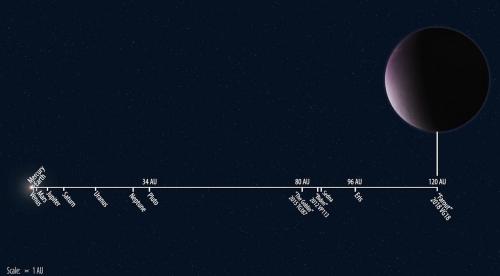
It would be logical to call every space discovery “far out,” but the newest one just announced two weeks ago seems to work.
Astronomers have uncovered an object (“Farout”) in our Solar System that’s farther than anything previously discovered. Farout is a temporary nickname by the scientists; officially, its moniker is 2018 VG18. Rough estimates put its size at 310 miles in diameter—which is big enough to pull itself into a somewhat spherical shape. By analyzing the dim light, scientists believe it glows with a pink hue color. The picture seen here is an artist’s rendering.
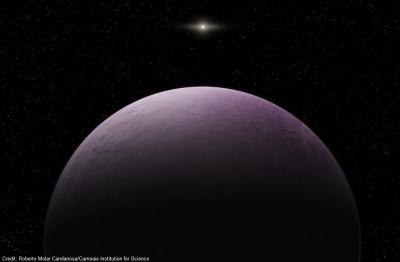 The newly uncovered world is 120 Astronomical Units (AU) away, or 11.2 billion miles, three-and-a-half times more distant than Pluto! One AU equals 93 million miles, the distance from the Earth to the Sun. Pluto is only 34 AU away, on average. Think of Farout’s great distance this way: Say we had a leftover probe ready to go and launched it tomorrow -- it would take about 40 years to get there! (And Farout is within our Solar System!)
The newly uncovered world is 120 Astronomical Units (AU) away, or 11.2 billion miles, three-and-a-half times more distant than Pluto! One AU equals 93 million miles, the distance from the Earth to the Sun. Pluto is only 34 AU away, on average. Think of Farout’s great distance this way: Say we had a leftover probe ready to go and launched it tomorrow -- it would take about 40 years to get there! (And Farout is within our Solar System!)
2019 Sky & Space Calendar Preview
January 1: New Horizons reaches Ultima Thule—Kuiper belt Object
January 3: Earth at perihelion, closest point to the Sun
January 3: China to land Chang’e 4 Lunar Rover
January 4: Latest sunrise
January 6: Partial Solar Eclipse -- China, Japan, Korea, Siberia
January 17: NASA-Space X: Launch Crew Dragon Spaceship
January 20-21: Lunar Eclipse, visible in Milwaukee 9:33 p.m. to 12:51 a.m. CST
January 22: Venus & Jupiter close in the morning sky
January 31: India Launch—Chandrayaa 2, Lunar Orbiter, Lander, and Rover
February 4: Asteroid 2002 AJ129 closest to Earth at only 2.6 million miles
February 5: Chinese New Year—Year of the Pig
February 12: NASA’s Juno spacecraft flies close to Jupiter (six more times in 2019)
February 18: Venus & Saturn close in morning sky
March 3-13: 50th Anniversary of Apollo 9
March 10: Spring ahead! Daylight Saving Time begins
March 14: Pi Day and Einstein’s Birthday
March 20: Spring begins at 4:58 p.m. CDT
April 4: Parker Solar Probe orbit close to Sun
April 6: 35th Anniversary: First orbital Shuttle repair mission (Solar Max)
May 4: 30th Anniversary - Start of five-year Magellan mission to Venus
May 17: 45th Anniversary - Launch of first geosynchronous weather satellite SMS-A
May 18-26: 50th Anniversary - Apollo 10—Module descends to 10 miles above lunar surface
May 27: 20th Anniversary - First human visit to International Space Station (ISS)
June: NASA-Space X to launch astronauts
June 9: Jupiter’s opposite the Sun, up all night
June 14: Earliest sunrise
June 18: Mars & Mercury very close in evening sky
June 21: Summer Solstice starts at 10:54 a.m. CDT
June 27: Latest sunset
July 2: Total Solar Eclipse—South Pacific, Chile, and Argentina
July 4: Earth at aphelion, the farthest point from the Sun
July 8: Saturn opposite the Sun, up all night
July 11: 40th Anniversary - Skylab falling back to Earth
July 16: Partial Lunar Eclipse—Europe, Africa, west-central Asia
July 16-24: 50th Anniversary - Apollo 11—first Moon Walk
August 12-13: Perseid meteor shower peaks
August 13: Venus at superior conjunction—behind the Sun
September 1: Parker Solar Probe orbit close to Sun
September 9: Neptune at opposition
September 23: Fall arrives with the autumnal equinox at 2:50 a.m. CDT
October 28: Uranus at opposition
November 3: Fall back! Daylight Saving Time ends
November 11: Mercury Transits the Sun; visible in Milwaukee 6:41 a.m. to 12:04 p.m. CST
November 14-24: 50th Anniversary - Apollo 12
November 23: Venus & Jupiter close in evening sky
December 8: Earliest sunset
December 10: Venus & Saturn close in evening sky
December 13-14: Geminid meteor shower peaks
December 21: Winter Solstice starts at 10:19 p.m. CST
December 26: Annular Solar Eclipse—Saudi Arabia, India, Borneo
Sky Sights
Jupiter, Venus, and the Moon put on two great shows this January! Look southeast each clear morning and enjoy the views. See them all together on the first mornings of the new year, January 1-4. Then watch the three brightest night lights repeat this dazzling show January 30 to February 1, but with Venus and Jupiter in reversed positions.
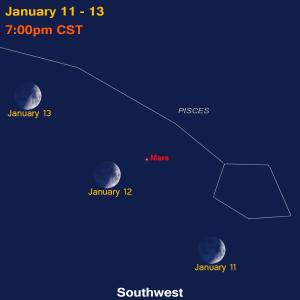 Mars is now all alone in the evening sky. You can see it easily among the dim stars in the constellation Pisces. As the red planet moves even farther from the Earth, it will dim even more in the sky. If your mind’s eye recorded its red brilliance back in July, it is quite a drop-off in brightness. The Moon swings by from January 11-13.
Mars is now all alone in the evening sky. You can see it easily among the dim stars in the constellation Pisces. As the red planet moves even farther from the Earth, it will dim even more in the sky. If your mind’s eye recorded its red brilliance back in July, it is quite a drop-off in brightness. The Moon swings by from January 11-13.
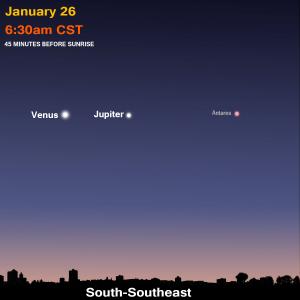 Watch each January morning as the two brightest planets slowly pass each other. They never get super close but they will captivate your celestial eyes. Their closest approach will be the morning of January 22. The two planets form a straight line with the red star Antares on January 26.
Watch each January morning as the two brightest planets slowly pass each other. They never get super close but they will captivate your celestial eyes. Their closest approach will be the morning of January 22. The two planets form a straight line with the red star Antares on January 26.
Saturn is in conjunction with (behind) the Sun in January as Earth passes it on the Solar System racetrack. By month’s end, the ring jewel becomes barely visible, rising at 5:43 a.m. CST, over one hour before the Sun comes up at 7:08 a.m. CST.
Mercury is out of sight all night.
January Star Map
Sign Up
Receive this newsletter via email!
Subscribe
See the Universe through a telescope! Join one of the Milwaukee-area astronomy clubs and spot craters on the Moon, the rings of Saturn, the moons of Jupiter, and much more.
 Follow Bob on Twitter @MPMPlanetarium
Follow Bob on Twitter @MPMPlanetarium


